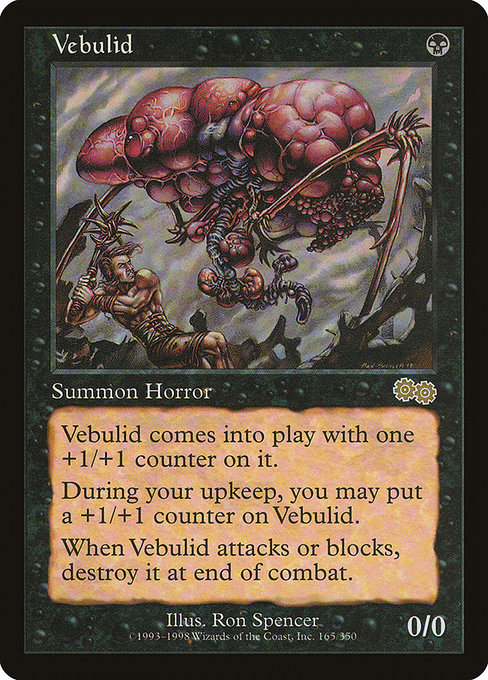
Image courtesy of Scryfall.com
Grouping MTG Cards by Shared Abilities: A Deep Dive with Vebulid
If you’ve ever shivered at the elegance of a well-crafted MTG mechanism, you’ve felt the same tug I do when I line up cards by what they do rather than what they cost. Clustering by mechanics isn’t just nerdy cataloging; it’s a way to see the game’s DNA—the way power scales, how tempo interacts with boards, and where players find delight in clever design twists 🧙♂️🔥. Our focus card—an artfully grim caricature from Urza’s Saga—gives us a perfect lens to explore one of the most enduring motifs in Magic: counters that promise growth, but with a built-in deadline that keeps the clock ticking. Let’s unpack Vebulid’s life cycle and then map it onto a broader taxonomy of similar mechanics, so you can spot these clusters in almost any deck you build or admire 🎲.
Vebulid is a rare black creature from the Urza’s Saga era (set in 1998), a time when the color pie was being stretched and twisted by Phyrexian horror themes. With a mana cost of {B} and a creature type listed as Phyrexian Horror, it immediately signals a dark, incremental strategy. Its base power and toughness are effectively 0/0, but it enters the battlefield “with a +1/+1 counter on it.” That single line inaugurates a theme you’ll see reemerge across many black and artifact-centered designs: growth through counters that come from the card’s own presence, not from a short-lived temporary buff. It’s a micro-arc—one turn at a time—that invites you to think about what it means to “get bigger over time” while staying mindful of the card’s catch: it won’t endure the usual long game. When Vebulid attacks or blocks, it’s destroyed at the end of combat. The timer is real, and it forces you to race, pump, or pivot before the clock runs out 🧭⚔️.
That combination of growth-on-entry and guaranteed end-of-combat removal creates a very particular cluster: a creature that embodies both incremental advancement and fragile persistence. In a game that’s as much about tempo as about raw stats, Vebulid rewards you for planning ahead. You may add another +1/+1 counter at the start of your upkeep, a kicker that pushes its power toward a tiny but stubborn crescendo. The fact that its growth is contagious through counters—rather than a one-shot boost—means it can interact with other counter-y themes and pump effects in ways that require careful timing. If you’re building a deck around +1/+1 counters, or around black’s darker philosophies of life and death, Vebulid slots into a family of cards that explores “how much can I grow before I disappear?” 🧙♂️💎
A Quick Look at the Mechanic Cluster
- Counter-entrance growth: Vebulid enters with a +1/+1 counter, immediately making it a 1/1 from a base 0/0 frame. This is a signature pattern for counters-based strategies—cards that reward you for building a board state via counters rather than raw immediate stats.
- Upkeep-based augmentation: At the beginning of your upkeep, you may add another +1/+1 counter. This steadily escalates the threat level or, at minimum, keeps the board honest as the game progresses 🧠.
- Temporary but potent threat: The “dies at end of combat” clause (triggered after it attacks or blocks) creates a built-in friction: you get a moment of impact, then a clean end. It’s a design that loves tempo games and forces you to decide whether to push through the pressure or pivot to another angle ⚔️.
- Color and flavor consolidation: Being a black creature with Phyrexian Horror flavor gives it a shared narrative with other dark, counter-centric or sac-outlet themes—cards that whisper about decay, persistence, and the uneasy charm of things that get bigger even as they fade away 🎨.
- Format considerations: Vebulid sits in formats like Legacy and Commander (and prints in older eras), rather than modern, but its mechanical resonance continues to echo in contemporary counter-based designs. It’s a reminder that elegance in MTG often travels across formats in surprising ways 🧲.
If you’re crafting a cluster deck or simply exploring how MTG designers carve out meaningful micro-arcs, this family of mechanics invites you to experiment with timing. Use a few “upkeep buff” enablers, or pair Vebulid with other menace-ish creatures that can poke for damage as it grows. It’s not about brute force; it’s about building a compelling mini-narrative on the board, where every counter is a glyph of intent and every end-of-combat wipe is a coda in a short, suspenseful song 🎵.
For the tactile among us, the ritual of organizing a play space can be as satisfying as organizing a mana base. If you’re looking for a desk companion that keeps up with your MTG musings, this neoprene mouse pad is a neat fit for casual desk setups or battle-table maps. It’s one more way to keep the hobby anchored in daily life—without sacrificing the joy of discovery 🧙♂️🔥💎.
Rarity and value are part of the conversation too. Vebulid’s rarity is rare in the Urza’s Saga print run, printed on black-bordered cards, nonfoil in the base release, with a modest market presence today. Its cost—barely a single black mana—contrasts with the layered timing of its growth and removal, reminding us that some of the most memorable MTG cards aren’t about overwhelming stats but about a clever idea that unfolds over time. The art by Ron Spencer adds that distinctive vintage vibe, a reminder that the game’s aesthetics were just as carefully sculpted as its rules 🪙🎨.
Neoprene Mouse Pad – Round or Rectangular (One-Sided Print)More from our network
- https://crypto-acolytes.xyz/blog/post/what-regulators-really-think-about-defi-in-2025/
- https://blog.digital-vault.xyz/blog/post/designing-editable-certificate-templates-tips-and-best-practices/
- https://crypto-acolytes.xyz/blog/post/splatoon-3-vs-splatoon-2-a-comprehensive-comparison/
- https://transparent-paper.shop/blog/post/designing-gratitude-journal-printables-layouts-tips-and-inspiration/
- https://blog.digital-vault.xyz/blog/post/mastering-niching-down-in-digital-markets-for-growth/